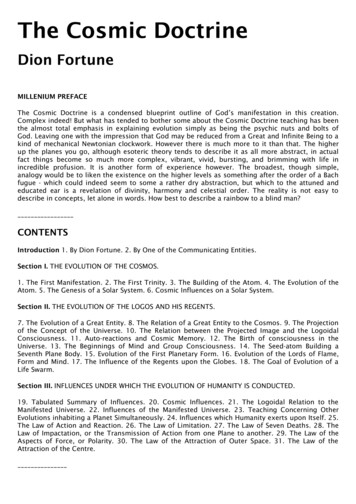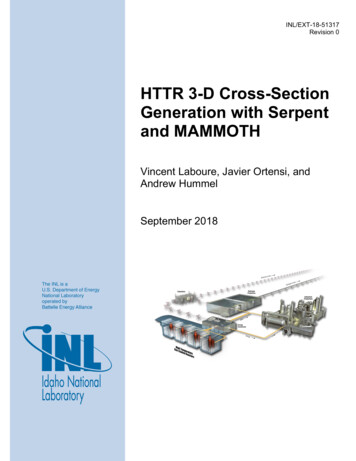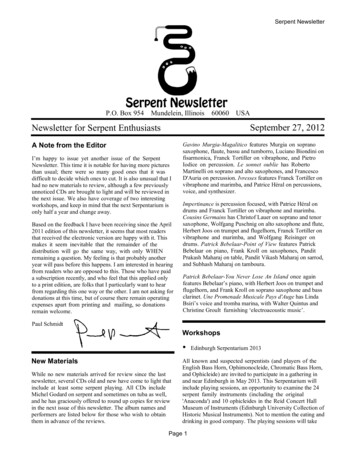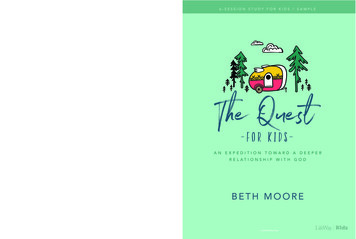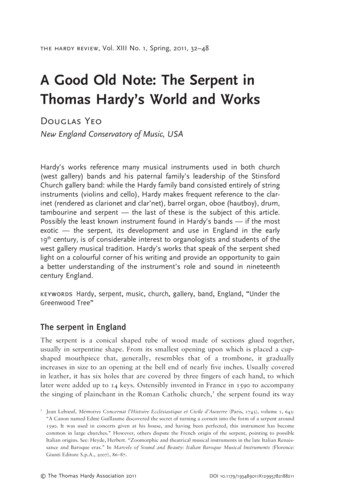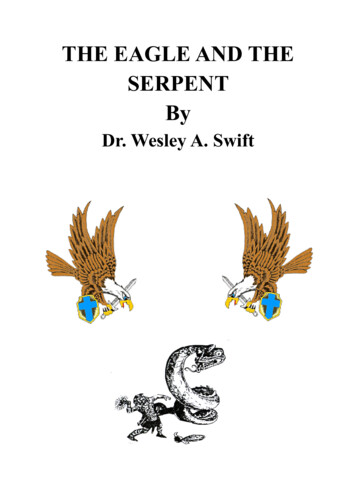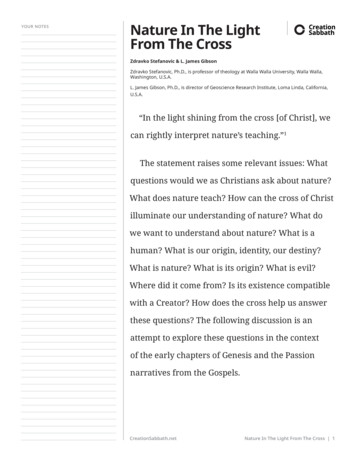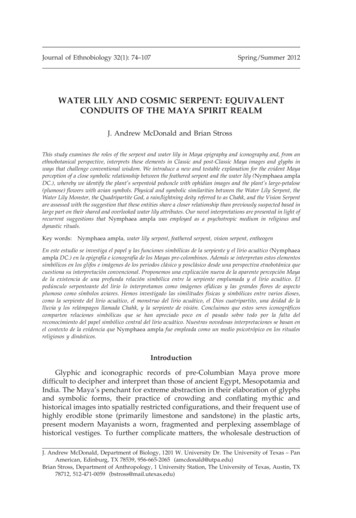
Transcription
Journal of Ethnobiology 32(1): 74–107Spring/Summer 2012WATER LILY AND COSMIC SERPENT: EQUIVALENTCONDUITS OF THE MAYA SPIRIT REALMJ. Andrew McDonald and Brian StrossThis study examines the roles of the serpent and water lily in Maya epigraphy and iconography and, from anethnobotanical perspective, interprets these elements in Classic and post-Classic Maya images and glyphs inways that challenge conventional wisdom. We introduce a new and testable explanation for the evident Mayaperception of a close symbolic relationship between the feathered serpent and the water lily (Nymphaea amplaDC.), whereby we identify the plant’s serpentoid peduncle with ophidian images and the plant’s large-petalose(plumose) flowers with avian symbols. Physical and symbolic similarities between the Water Lily Serpent, theWater Lily Monster, the Quadripartite God, a rain/lightning deity referred to as Chahk, and the Vision Serpentare assessed with the suggestion that these entities share a closer relationship than previously suspected based inlarge part on their shared and overlooked water lily attributes. Our novel interpretations are presented in light ofrecurrent suggestions that Nymphaea ampla was employed as a psychotropic medium in religious anddynastic rituals.Key words: Nymphaea ampla, water lily serpent, feathered serpent, vision serpent, entheogenEn este estudio se investiga el papel y las funciones simbólicas de la serpiente y el lirio acuático (Nymphaeaampla DC.) en la epigrafı́a e iconografı́a de los Mayas pre-colombinos. Además se interpretan estos elementossimbólicos en los glifos e imágenes de los periodos clásico y posclásico desde una perspectiva etnobotánica quecuestiona su interpretación convencional. Proponemos una explicación nueva de la aparente percepción Mayade la existencia de una profunda relación simbólica entre la serpiente emplumada y el lirio acuático. Elpedúnculo serpenteante del lirio lo interpretamos como imágenes ofı́dicas y las grandes flores de aspectoplumoso como sı́mbolos aviares. Hemos investigado las similitudes fı́sicas y simbólicas entre varios dioses,como la serpiente del lirio acuático, el monstruo del lirio acuático, el Dios cuatripartito, una deidad de lalluvia y los relámpagos llamada Chahk, y la serpiente de visión. Concluimos que estos seres iconográficoscomparten relaciones simbólicas que se han apreciado poco en el pasado sobre todo por la falta delreconocimiento del papel simbólico central del lirio acuático. Nuestras novedosas interpretaciones se basan enel contexto de la evidencia que Nymphaea ampla fue empleada como un medio psicotrópico en los ritualesreligiosos y dinásticos.IntroductionGlyphic and iconographic records of pre-Columbian Maya prove moredifficult to decipher and interpret than those of ancient Egypt, Mesopotamia andIndia. The Maya’s penchant for extreme abstraction in their elaboration of glyphsand symbolic forms, their practice of crowding and conflating mythic andhistorical images into spatially restricted configurations, and their frequent use ofhighly erodible stone (primarily limestone and sandstone) in the plastic arts,present modern Mayanists a worn, fragmented and perplexing assemblage ofhistorical vestiges. To further complicate matters, the wholesale destruction ofJ. Andrew McDonald, Department of Biology, 1201 W. University Dr. The University of Texas – PanAmerican, Edinburg, TX 78539, 956-665-2065 (amcdonald@utpa.edu)Brian Stross, Department of Anthropology, 1 University Station, The University of Texas, Austin, TX78712, 512-471-0059 (bstross@mail.utexas.edu)
Spring/Summer 2012JOURNAL OF ETHNOBIOLOGY75Maya literature, art and religion by Spanish clergy during the 16th-centuryconquest of Mesoamerica left historians few reliable points of cultural referenceon which to base current and historical suppositions, iconographic interpretations, and evolving debates on the early beliefs and ritual practices of Mayacommunities.The present attempt to explain the close relationship between two uniqueelements of Maya symbolism –the serpent and water lily– offers an instructivecase in point. Analogous uses of these same motifs in mythic and iconographictraditions of ancient Egypt, Mesopotamia, the Mediterranean and India havebeen examined and outlined in some detail by Old World historians (Bosch 1960;Fergusson 1971; Goodyear 1891; Lahiri 1984; McDonald 2002, 2004; Vogel 1926),but such is not the case with respect to floral and ophidian symbolism inMesoamerica. Preliminary explanations for the symbolic meaning of the Mayaserpent and water lily vary considerably among authors, just as Mayanists haveyet to recognize, much less examine in detail, the traditional practice of unitingthese motifs in iconographic media.Few historians would disagree that serpent imagery stands out as one of themore common and variable zoomorphic symbols in Mesoamerica (Baldwin1998:26; Miller and Taube 1993:149), but the underlying significance of symbolicpermutations of the image is still poorly understood. Above all, serpent imagesare associated with water, both in the form of rain and of bodies of standingwater, including the watery underworld of Maya cosmology. In this context,iconic serpents are frequently associated with images of mollusks and fish,leading some commentators to identify the sacred reptile as a primordial denizenof fertile bodies of water, if not the embodiment of water itself (Bassie-Sweet2008:90; Miller and Taube 1993:150; Schele and Miller 1986:46; Tozzer and Allen1910:314).Alternatively, placement of serpent images along the foundations, balustrades, and lintels of focal structures in ancient urban centers of Mexico andCentral America was at times intended to identify these buildings with themythic image of a ‘serpent-mountain’ known as the chan-witz or kan-witz (cf.Schele and Kappelman 2001; Schele and Mathews 1998:43) to Maya speakers andcoatepec to Aztec traditionalists, ostensibly identifying the snake as a symbol ofthe earth (cf. Luckert 2001; although Schele and Miller (1986:47) assert that no‘‘personified form of the earth has yet been identified’’). Entrances to the innersanctums of these structures at the ground floor and summits are frequentlydepicted as the mouth of a serpent and are therefore believed to represent aportal between the natural world and the Maya watery Netherworld (Freidelet al. 1993:370; Miller and Taube 1993:150, 370; cf. Schele and Mathews 1998:43).Passage through the maw of the dragon was likely perceived by Maya dynastsand attendant elites as a transformative exercise that served to identify certainmembers of the ruling classes as divine (Stross 1996).Paradoxically, the cosmic dragon of Mesoamerica (Celestial Monster,Bicephalic Monster, or Cosmic Monster) is also identified with the sky (Freideland Schele 1988:73; Schele and Miller 1986:47), his body frequently exhibitingprominent feathers or providing a perch on which a divine bird displaysoutstretched wings and flamboyant sprays of feathers. The front head of this
76MCDONALD and STROSSVol. 32, No. 1ophidian monster is usually crocodilian while an occasional inverted skeletalhuman skull is observed on the serpent’s tail (i.e., the ‘bicephalic monster’), thelatter bearing at times a ‘quadripartite badge’ headdress (see below). Linguistsoften emphasize the fact that Maya words for ‘sky’ and ‘serpent’ are nearhomophonic (chan or kan) and note that the extended body or coils of thecreature occasionally represent a sky-band, in that the tubular body oftencontains symbolic signs that are believed to represent the sun (k’in), moon (uh),stars (ek’ ) and darkness (ak’bal). This celestial aspect of the serpent can be foundin contemporary folklore as well as temple imagery connected with atmosphericphenomena, such as clouds (Schele and Mathews 1998:238), lightning bolts(Miller and Taube 1993:150; Taube 1992:17, 19), and rain (Tozzer and Allen1910:314), underscoring again a heavenly dimension to what is often viewed as achthonic (underworld) symbol. Indeed, some commentators have interpreted theserpent’s extended body as a representation of heaven’s vault, its arching coilssetting a celestial course for the sun (Miller and Taube 1993:150; Sosa 1986;Tozzer and Allen 1910:315), stars (Spinden 1913:59; Tozzer and Allen 1910:314)and Milky Way (Freidel et al. 1993: 151; Milbrath 1999:40–41).On a functional level, therefore, the divine serpent, feathered or otherwise,can be seen as a symbol of recurrent natural processes in the earth, bodies ofwater, and sky, with particular emphasis on a relationship with water. On onelevel, ophidian symbolism in Mesoamerica appears to signify a cosmic principlethat embodies the interactions and phenomenology of chthonic and atmosphericforces and elements. But on another level, serpent imagery also seems to havebeen employed as a symbol of transcendence, serving as a divine conduitthrough which priests, aristocrats, souls, ancestors and deities were transportedbetween the natural world and the supernatural otherworld of the gods(Gendrop 1980; Miller and Taube 1993:150; Stuart and Stuart 2008:173). Thisgeneral concept was apparently important to Maya priests and aristocrats, asserpent imagery played a versatile role in ritual and iconographic practices.By virtue of close and recurrent iconographic associations between the divineserpent and water lily, we can only assume that the symbolic significance of thisplant form overlaps to a certain extent with that of its reptilian accessory. Bothliving forms are associated with water and both frequently interact with eachother in iconographic expression in this recurrent context. While few investigators have appreciated the degree to which the water lily flower is associated withthe serpent, even fewer have acknowledged the serpent as a metaphor for part ofthe water lily itself (or vice versa). What has been acknowledged, at least as aguiding generality, is that the serpent and the water lily share close affinities withaquatic, fertile environments (Alcorn 1984:714; Miller and Taube 1993:150;Puleston 1977; Robicsek 1981:149). This perspective seems logical, given thataquatic habitats are a consequence of rainy seasons and that summer precipitation cycles are a perceptual cause and/or effect of solar, stellar and planetaryrotations, as well as biotic cycles of life and death (Cohodas 1982). Hence therelationship between the serpent, water lily, and atmospheric forces is areasonable and plausible symbolic construct.In this general context, some authors have identified the water lily withnatural principles that govern birth, the regeneration of life, and the fate of
Spring/Summer 2012JOURNAL OF ETHNOBIOLOGY77successive dynasts (Rands 1953; Robicsek 1981:149). Naturally, the return of therainy season correlates with the greening of landscapes, especially in lowlandbasins where water lilies thrive; and consequently, the water lily is recognized asa symbol of fertility and living creation (Miller and Taube 1993:184; Schele andMiller 1986:11). We are particularly interested here in building upon the knownand obvious relationship of the water lily with bodies of water and various kindsof reptilian entities (primarily the serpent and crocodile), with an aim to exploreand discover more about the depiction, classification, and symbolic meaning ofwater lilies and serpents to Mayans of the past and present.Our data and synthesis are based on a broad survey of images that cover aconsiderable span of time and space in Maya history, focusing primarily oniconography that dates from the late Classical to post-Classical periods (8–16thcenturies). Ceramic paintings (Figures 2, 5, 7) from the Justin Kerr Maya VaseDatabase (Appendix 1) provide the most detailed and eclectic source ofinformation, but these treasures usually lack context in terms of their age andprovenance due to the careless methods of clandestine collectors. Conversely,professional archeologists have uncovered, dated and documented bas-reliefs instucco and stone that provide both chronological and geographical perspectiveson Maya culture and history (Figures 8a–f, 9). Imagery and glyphic records fromthese sources provide an abundance of evidence to decipher past beliefs, mythictraditions, and ritualistic practices of lowland Maya communities from northernYucatan (Dzibilchaltun and Uxmal) to Palenque and as far west as Copan,Honduras.Iconographic Representations of the Mayan Water LilyRealistic and Stylized Representations of the Water LilySome of the earliest works on Maya iconography during the turn of the 20thcentury report a close association between the serpent and a botanical motif,several noting specifically that the creature shares a direct relationship withwater lilies (Maudslay 1889–1902; Spinden 1913:45, 64–65, Figure 79). The fullcomplexity of this relationship in the visual arts was poorly understood untilRands (1953) undertook a detailed investigation of Maya water lily imagery, inwhich 18 definable motif types were recognized based on five distinguishablevisual perspectives. Natural depictions of the water lily plant, such as thoseexecuted occasionally on ceramics or as adornments of elites and maskedindividuals on mural paintings (Freidel et al. 1993:238, Figures 5:3 and 5:4),exhibit sufficient botanical detail to identify the vegetative image with certaintyand to distinguish the plant from other floristic elements of southern Mexico andCentral America. Renderings of large and solitary, radially symmetrical flowerswith numerous white petals, and with an array of yellow stamens and a crownshaped ovarian disk from 1 to 1.5 cm wide (Figure 1), leave little doubt thatNymphaea ampla is the species in question (Rands 1953). As well, these diagnosticfloral features agree botanically with the plant’s vegetative structures, mostnotably by their floating, heart-shaped leaves with dentate blade margins and anundersurface that exhibits a prominent reticulum of veins (Figures 1a, d, 2, 4c,5a,b, 6a).
78MCDONALD and STROSSVol. 32, No. 1Figure 1. Maya Water Lily (Nymphaea ampla) morphology. a) Aquatic habit of maturing leaves andflowering shoots. b) Lateral (profile) view of water lily flower, emphasizing a basal triad of greensepals. c) Radial view of the flower during the first of three days of anthesis. White petals surroundinga sun-like display of yellow stamens and ovarian disk. d) Four purple-punctate sepals reflex duringflorition, marking the flower as tetramerous. e) After three days of flowering, peduncles either sink orrecoil in a snake-like fashion into the water to initiate fruit development. f) The water lily fruit, anaquatic berry, exhibits petal scars on its sides and a cupulate, nippled (umbonate) apex.Unlike most aquatic plants of the Maya lowlands, N. ampla presents fourlarge, green sepals during anthesis, three of which stand out prominently in aprofile view of the flower (Figures 1b, d, e, 2, 4a–d, 5b, c, 6d, 7a, e, 8g, 9f) as atrident (trefoil, or Mesoamerican fleur de lis sensu Cohodas 1982) of calyxsegments, each exhibiting dark, pigmented blotches on the their outer surface(Figure 1a, d). Portrayals of such flowers at Bonampak (Figure 4b) and on stelae
Spring/Summer 2012JOURNAL OF ETHNOBIOLOGY79Figure 2. Maya twin mythic figures uphold and spring from Nymphaea ampla flowers. Note thecollective use of various symbolic forms, including ajaw signs, cross bars, bird plumes, Chahk’s axand God C, to portray the water lily in a narrative context, the underlying meanings of which are stillobscure. Codex style ceramic painting, provenance and date unknown. Photograph E Justin Kerr,K8498.at Machaquilá (Figure 6d) tend to exaggerate the length of the sepals and renderthe white petals in a comb-like fashion (Figure 2).True to the plant’s natural form, the flower’s peduncle is portrayed as a thickand supple feature (Figures 1a, e, f, 4a–c, 5a–c), stylized renderings of whichsometimes tie the fleshy stalk into a single square knot (Figures 4h, 6d), a seriesof rounded knots (Figures 5a, 6a; Appendix 1.A1), or a herring-bone motif that isreminiscent of a linear Gordian knot (Figure 7f; the ‘‘plaited’’ or ‘‘braided mat’’motif sensu Proskouriakoff 1950:64, Figures 22 A1, VIII-B1, VIII-C1; Cohodas1982, Figure 3). Water lily flowers placed around the ankles of kings in divineregalia often lack sepals but exhibit a compact grouping of petals on the dorsaledge of the flower and a hemispherical arch of dark stipples on the flower’sventral surface (Figure 4g). This particular motif is clearly homologous to severalglyphs of Classic Maya script that relate to the water lily. One of these, with asyllabic value of ja (probably derived from ja’, ‘water’), in some contexts standsfor the word naab, which can mean ‘water lily,’ ‘handspan,’ or ‘lake’ (Figure 3a).Two additional pictorially related glyphs are imix (Figure 3b; T5011; Montgomery 2002:97) and b’a (Figure 3c; T501; Montgomery 2002:39).The Maya conventionally executed the flower in the abstract and employed anumber of stylistic conventions throughout the Classic (250–900 CE) and postClassic (900–1500 CE) periods that allow for easy identification of the motif. BothSpinden (1913:18–19) and Rands (1953) recognized two standard perspectives onthe floral motif: symmetrical (Figures 4a–c, 5a–c) and asymmetrical (Figures 4e,h, 5d–f, 9a, b), both of which are associated with an herbivorous fish (Figures 4e,6a, d) and a basal, elongated, horizontal bar (Figures 4h, i, 9c–f) that is frequentlydecorated with three prominent circlets (Figures 4e, i, 5f, 9f).While the classification scheme and lengthy discussion of water lily motifs byRands (1953) is complicated for the intentions of the present discussion, thesynthesis provides an informative introduction to the symbolic meaning of themotif based on its associations with a variety of gods and divine creatures, mostnotably serpents of various shapes and aspects (Figures 6a–c, 7a–f, 9f), crocodilesor crocodile-faced serpents (Figures 4b, 6b, 7b–e), fish (Figures 4e, 6a, d), several
80MCDONALD and STROSSVol. 32, No. 1Figure 3. Variants of the water lily glyph and the flower/lord glyph. a) Water lily image (flower and/or pad) with darkened infix reads as either naab’ (‘water lily’) or ha’ (‘water’). b) Water lily image incartouche and with mirror infix is usually called imix. c) Water lily image with mirror infix, read asb’a (‘first,’ ‘self,’ or ‘image’) and as the syllable b’a. d) A face (and/or flower) image in the cartouchereads as ajaw ‘lord’ and represents the last in the 20 day name calendar sequence. e) Conflation of twoglyphs, including the ‘‘face’’ image, reads as sak nik, ‘white flower.’ f) ‘‘Face’’ image with infixed‘‘cap’’ reads as nik, ‘flower’: with a mirror image as a suffix reads as –li or –il. g) Water lily image withan infixed ‘‘face’’ image reads as the syllable ma or as the word ma ‘great’ or ‘revered.’aquatic birds (i.e., cormorants, herons, limpkins, ducks), a jaguar (4a), and fullyor partially anthropomorphized deities (Figures 5a–f, 6a, c, 8a–h, 9a–e). Thecomplexity of the subject is further complicated by the Maya’s frequent portrayalof bizarre chimerical creatures that combine features associated with theaforementioned animals. Nevertheless, floral designs associated with thesesupernatural figures are consistently portrayed with sufficient precision tousually identify them as water lilies.Linguistic and Glyphic Representations of the Water LilyHistorical and contemporary vernacular names of N. ampla betray a numberof mythic and religious roles of the plant in antiquity. Martinez (1979:1133)identifies two widespread Spanish names for the plant that suggest a solarcharacter –sol de agua and hoja de sol– which Hellmuth (1987 I:155) relates to theplant’s preference for full sunlight in aquatic habitats. The sun-and-flowerassociation is at least as likely attributable, however, to the flower’s morphological solar aspect, the centralized golden ovary and radiate array of goldenstamens suggesting the image of a beaming sun (Figure 1c); for indeed, waterlilies throughout the world are frequently identified with the sun and a host ofsun-gods (Goodyear 1891; McDonald 2002).In support of this interpretation, the Maya sometimes placed an ajaw sign, aface-like symbol meaning ‘lord’ and related to the sun god (Figure 3d;Montgomery 2002:27), within a radial array of water lily petals (Figure 5d),
Spring/Summer 2012JOURNAL OF ETHNOBIOLOGY81within water lily buds (Figure 2; Appendix 1.A2), and on the tips of the teethalong the water lily leaf margin (Figure 2). In Maya glyphics, the ajaw sign islikewise infixed into a water lily to form the ma glyph (Figure 3g; Montgomery2002:166) or otherwise, when capped, translates as ‘flower’ (with a li suffix,sometimes present, i.e., nik-li or nich-il, Figure 3f; Montgomery 2002:184). Therelated sak nik (or sak nich) glyph (‘white flower’ T179, Figure 3e;Montgomery 2002:215), which conflates the glyph for white with an infixedajaw sign, refers to the flowery soul of expired elites. Although Schele (Freidelet al. 1993:395–396) identifies the sak nik as a ceiba flower, the white flower ofNymphaea ampla seems to better fit the ajaw signs found on both the glyphs for‘flower’ and the glyph for the syllable ma (Figure 3g), which can be describedas the glyph for ‘water lily’ and ‘water’ with an ajaw sign substituting for acrosshatched oval.Martinez records three additional Yucatec names for the plant, lab, lòol ha’and sak-chab, the former two seeming to reflect iconographic and mythicconcepts of the plant in Maya history. Lab (‘old’) perhaps identifies the plant as aprimordial, creative principle, since the name complements the role of the waterlily glyph (imix) in the Maya calendar as the initiator of the 20-day count, asnoted by Bishop Diego de Landa (Garibay 1966:70, 74; Puleston 1977). This floralconcept of incipient time is also likely related to the glyphic sign for ba, or ‘first’and ‘self, face’ (Montgomery 2002:39), a combined water lily and mirror glyph(Figure 3c). The initial calendric position of a water lily glyph –which others havesuggested to be a lily pad (Thompson 1970:73), but which we are interpreting asthe water lily flower, as does Thompson (1970:72)– in addition to its Yucatecnames, may also relate directly to the mythic traditions of the lowlandLacandons, who believe in a deity on the middle level of the heavens by thename of K’akoch that created the lowland Maya pantheon from a primevalflower or specifically, from the water lily according to Bruce (1967; cf. Miller andTaube 1993:184; Robicsek 1981:149; Thompson 1970:202).The most common word for water lily, naab, shares a common root with theword for lake (Schele and Miller 1986:60), the glyph for which is T501 (Figure 3a),much as the glyph for imix is a down-turned water lily flower motif, but with amirror motif infixed in the oval centered toward the top of the motif instead of across-hatched oval (Figure 3b; Montgomery 2002:178), this being almost identicalto the glyph for phonetic b’a (Figure 3c), but for the surrounding cartouchewhich makes it a day name instead of a phonetic complement. The nen and lisigns (both thought to represent images of mirrors), while functioning asphonetic complements in glyph blocks mentioned in connection with glyphsrelated to the water lily, may be independently relevant to floral symbolism inpre-Columbian Maya iconography, as water lily buds and flowers are alsofrequently decorated with these signs (Figures 5b, 6d, 8a, b; Appendix 1.A3), asare deities that present the flower as their attribute (Figures 8g, h; Appendix1.A4). These glyphic relationships are consistent with yet other names for thewater lily in Yucatec (Barrera Vasquez 1980:546), such as nukum naab (big waterlily), sak naab (white water lily), nikte’ ha’ (water flower) and lòol ha’ (largeflower of the water). A more peculiar but very significant name for the water lilyamong modern Yucatecs, xikin Chahk (‘ear of Chahk’), is discussed below.
82MCDONALD and STROSSVol. 32, No. 1Figure 4. Variations on iconographic depictions of the water lily (flowers shaded). a) Water Lily Jaguarfrolics with his signatory flowers in the company of fish. Trefoils of punctate sepals expand to revealthe polypetalous corolla; paired water signs (‘‘shell scrolls’’ and three-stacked bars) on the body of thefeline connote an aquatic activity. Ceramic painting of unknown date and provenance. b) Crocodilegod adorns himself with water lily flowers. A radial view of the flower bears of three dark orbs andserves as an ear plug. Mural, Bonampak, Chiapas, Mexico. c) A stylized leaf and flowering shootemerge from an aquatic skull (WLM). The flower presents a trefoil of sepals that cradles two smallradiant orbs. Palenque, Guatemala. After Maudslay (1889–1902). d) A long-nosed skull sprouts fourstylized water lily flowers from his ears and cranium. All four flowers are variations on the trefoilscheme, while the cranium likely represents an imix (water lily) glyph. After Kerr 3151. e) Anasymmetrical water lily with three basal orbs is consumed by a fish. Copan, Honduras. f) A stylized
Spring/Summer 2012JOURNAL OF ETHNOBIOLOGY83Interpreting Homologous Floral Features of the Maya PantheonWater Lily MonsterOf several Maya entities that share a close association with the water lily, the‘Water Lily Monster’ (WLM) is the most enigmatic. This creature was a popularsubject of Maya ceramicists and was consistently portrayed as an aquatic,underworld skull (Figures 4c, 5, 6b, 9a) whose cranium and/or ears (rarely theeyes; Figures 4i, 5d; Appendix 1.B1) sprout forth water lily leaves, flowers, buds,and fruits. A natural denizen of the Maya underworld (Xibalbá), the WLM’siconographic attributes include a jawless skull (Figures 5c–e) or skinlessmandible (Figures 4c, 5a, b, 9a), a long upper lip with snout-like qualities (withsome exceptions, Figure 5a), scrolled pupils (Figures 4c, d, h, 5b, c, f, 9a), either abald cranium (Figures 4c, d, 5a, c, 9a) or a shortly trimmed ridge of hair atop hisforehead (Figures 5d–f), and large ear ornaments (Figures 4d, 5a–f, 9a). The god’scranium occasionally supports a bifid element that is usually identified as eithera smoke or vegetative motif (Figure 6b, c; Appendix 1.B2).WLM is frequently associated with a hungry fish that orients his gaping,toothed mouth toward the plant’s full-blown flowers. The fish often exhibits astylized water lily (trident and petaloid comb) for a dorsal fin (Figure 6a; Appendix1.B3) and a bifid scroll for tail fin (Figure 4e; Appendix 1.B4), both of which arefrequently displayed by the WLM (Appendix 1.B5). In addition to the fish, a varietyof symbols are associated with the WLM’s forehead and ear flares, such as the ajaw(‘lord’) sign (Figures 4c, 5b, d–f, 6c, 9c, d), a k’an-cross (meaning ‘yellow’ or‘precious’; Figure 5e, f; Appendix 1.B6), and several water symbols, includingthree-stacked bars (Figures 4c, 5a; Appendix 1.B7), ‘‘shell scrolls’’ (Figure 5a, b, e;Appendix 1.B8), or groupings of liquid droplets (Figure 5b–f; Appendix 1.B9). Thesmall and clustered liquid drops, often identified as a sacramental liquid known asitz (see below), should not be confused with the three prominent circlets that areoften observed at the base of the god’s flowers and fruits, which are often enclosedwithin a horizontal bar (Figures 4e, f, i, 5f, 9f; Appendix 1.B10).While the facial and floral details of the WLM vary considerably, the leavesare portrayed in a very conventional manner. The cranium’s leaf pads aregenerally rotund and do not typically exhibit the blade’s basal cleft (Figures 1e,4c, 5a, b). True to the plant’s natural form (Figure 1), the lamina displays a seriesof rounded teeth along the margins (Figures 2, 5a, 6a; Appendix 1.B11), whichMaya artisans frequently portrayed stylistically as three or four lumpyprotuberances along the margin of a half-folded blade (Figure 4c; Appendixrtrefoil ceramic painting typifies symbolic portrayals of the water lily. Note three orbs form the base ofthe flower. Ceramic, Tikal Museum, Guatemala. g) The imix glyph is based on a water lily motif andfrequently occurs on shields and ankle straps. The polypetalous corolla extends from a hemisphericalarch of stipples. Copan, Honduras. h) An asymmetrical flower with a knotted peduncle adorns aChahk mask. An extension of the peduncle loop dangles two ‘white flower’ (nik te ha) motifs,reflecting the opposing water lily. Copan, Honduras. i) A WLM/Cauac mask presents water lilytrefoils for eyes. The triple-orb pad serves as a floral eyebrow. Peduncles that frequently stream fromthe mouth are replaced with serpents. Tikal, Guatemala.
84MCDONALD and STROSSVol. 32, No. 11.B12). Each rounded tooth is occasionally associated with an ajaw facial motif(Figure 2), while a mesh of interwoven veins on the undersurface of the bladecreates a tightly configured mosaic of rhomboidal or polygonal segments(Figures 2, 4c, 5a, b, 6a). Inside each polygon is often observed a prominent darkspot, ostensibly representing dark-purple blotches that naturally cover theundersurface of N. ampla leaves (Figure 1a).WLM’s long, tubular peduncles are decidedly serpentoid in character(Figures 4a, c, d, h, 5b, c, 8g) and extend beyond the creature’s face, usuallymaking right-angled turns before terminating in a floral or fruiting structure.Flowering stalks usually diverge in pairs and conventionally extend to oppositepoles of the cranium, their bases attaching to the skull by a series of sheaths and/or knots (Figures 4c, 5a–c). At the tips of each peduncle are borne solitary flowersin various stages of anthesis: i.e., as a bud, full-blown or spent flower (Figure 1a–e). Symmetrical flower designs can be described as deltoid (Figure 4a, c, g, 5a) orcupular (Figures 4b, 5b, c, 8g), but these are often rendered in the abstract aspermutations on the trident (Figures 4d, f,
large part on their shared and overlooked water lily attributes. Our novel interpretations are presented in light of recurrent suggestions that Nymphaea ampla was employed as a psychotropic medium in religious and dynastic rituals. Key words: Nymphaea ampla, water lily serpent, feathered ser




